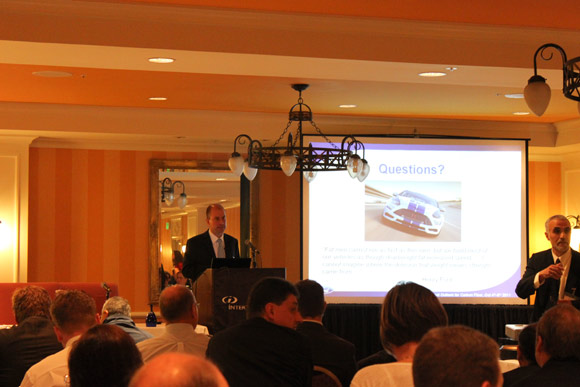Today was the first day of the Go Carbon Fiber 2011 conference held in Seattle, Washington. Â We wanted to share with you guys some of the discussions that were of interest to us in regards to the carbon fiber industry.
The first portion of the day was dedicated to the automotive industry, as we heard from Lamborghini, Ford, Lotus, SGL (BMW) and GM.
Up first was Professor Paolo Feraboli, representing the Automobili Lamborghini Advanced Composite Structures Lab at the University of Washington and his colleague Attilio Masimi, lightweight construction expert at Lamborghini.  Masimi went on to explain the benefits of using CFRP over aluminum.  Among them was the improved safety, possibility of integrating parts/components and lifespan.  On the integrating parts front, Masimi showed an interesting slide where an aluminum hood needed 11 parts, while the CFRP version was able to be done in just 2 parts making manufacturing much simpler.
More manual/labor intensive methods for manufacturing require 50% of the total part cost to go into assembly.  Newer methods like RTM (Resin transfer molding) help cut that down.  Lamborghini was adamant about the future of carbon fiber technologies is centered around ways to reduce final part acquisition costs and increase part manufacturing rate.  This is achieved by 3 ways:
- Reduced part count in assembly
- Increased manufacturing rate
- Lower raw material costs
In opposition, Ford stated that reduced part count may not work as well for their high-volume business because of things like manufacturing rate and repair.
Another interesting thing that Lamborghini mentioned is that the Sesto Elemento, which weighs 999 kg, actually had to have 12 kg added because the final car weighed 987 kg but the marketing concept was important to have it be 999 kg because of it’s name.
Lamborghini also brought out their new Aventador, which replaced the Murcielago:

We won’t get into the whole SGL/BMW partnership because there’s a ton of information out there, but we’ll go over a couple key points we took away from SGL’s presentation. Â SGL built a plant in Moses Lakes, WA…they invested $100m that created 80 jobs and 2 carbon fiber production lines. Â SGL is not part of the entire process, in fact they are essentially the suppliers of the material, which is a 50k carbon fiber that is not aerospace-grade. Â There was also a great quote we took away:
“…As for future developments, if successful, and we will be, other automakers will follow.”
We also heard from Ford, who brought up interesting points about how carbon fiber can be brought into high volume production.  Just to give an example, Boeing makes 10 planes a week, Aston Martin did about 10 cars a week (When Ford owned them) yet Ford produces over 100 F150’s in an hour (1 every 36 seconds).  It’s just a much higher scale.  Another example, if Ford transitioned their thermoset composites alone from a glass fiber to carbon fiber, they would require around 30,000 metric tonnes of carbon fiber a year.  The current forecast for global carbon fiber production is around 60,000 metric tonnes.  So you can see how there is a bit of a supply/demand issues at play.  Aside from that, Ford has billions of dollars invested in their infrastructure, some of it that dates from long ago.  It would require a lot of money to change that infrastructure.

GM made some interesting points about the R&D that is required for evaluating the effect of damaged carbon fiber. Â If you had a carbon fiber car and get into a small fender bender, do you lose structural integrity? Â Tools have to be built to quickly analyze parts to see what repairs have to made. Â They believe that many tech and economic hurdles have to be overcome before widespread usage is enabled.
There was quite a bit of talk about carbon fiber recycling.  We heard from Boeing, whose vision is sustainable environment solutions and reducing C02 by maximizing recycling.  They hope to work with the industry towards having a 90-95% recyclable aircraft by 2016.  Their approach is to reduce waste and improve recycling processes.  On the recycling front, we also heard from the CEO of Material Innovation Technology, who specializes in doing just that.  Their process, which we hope to write more about in the future, can do things like take the wing of a carbon fiber F18 and turn it into a Corvette part that exceeds GM’s spec.  They work closely with Boeing for recycling, and are even the company behind Trek’s recycling program.  In fact, one of the ideas is to take Trek’s bikes, and turn them into an affordable, sub $50 carbon fiber bicycle helmet.  At the end of the day, even though recycled carbon fiber has the potential to be strong, Boeing has already gone on record to say that they will not do a mission critical part like a wing or fuselage using a recycled part.
The last part of the day, one of the most entertaining, was the speech from Poggen Pohl. Â Their company partnered with Porsche Designs to create a high-end luxury kitchen that utilizes carbon fiber from a pure design aesthetic. Â It was great to see a luxury brand (the #1 luxury kitchen brand) align themselves with the material as a high-end product.